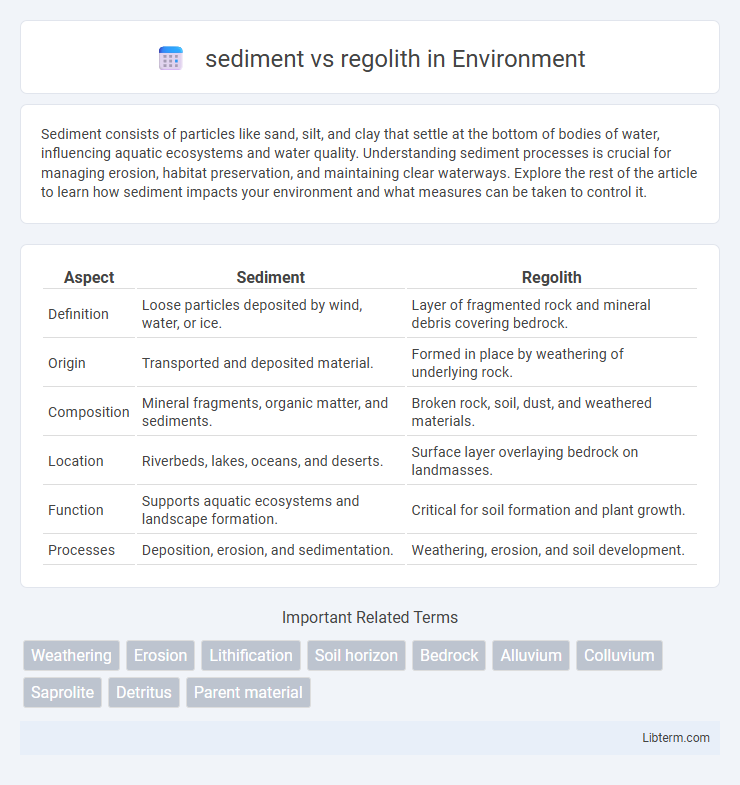Sediment consists of particles like sand, silt, and clay that settle at the bottom of bodies of water, influencing aquatic ecosystems and water quality. Understanding sediment processes is crucial for managing erosion, habitat preservation, and maintaining clear waterways. Explore the rest of the article to learn how sediment impacts your environment and what measures can be taken to control it.
Table of Comparison
| Aspect | Sediment | Regolith |
|---|---|---|
| Definition | Loose particles deposited by wind, water, or ice. | Layer of fragmented rock and mineral debris covering bedrock. |
| Origin | Transported and deposited material. | Formed in place by weathering of underlying rock. |
| Composition | Mineral fragments, organic matter, and sediments. | Broken rock, soil, dust, and weathered materials. |
| Location | Riverbeds, lakes, oceans, and deserts. | Surface layer overlaying bedrock on landmasses. |
| Function | Supports aquatic ecosystems and landscape formation. | Critical for soil formation and plant growth. |
| Processes | Deposition, erosion, and sedimentation. | Weathering, erosion, and soil development. |
Introduction to Sediment and Regolith
Sediment consists of particles derived from weathered rock or organic material transported by wind, water, or ice, accumulating in layers on the Earth's surface. Regolith is the blanket of loose, heterogeneous material covering solid bedrock, including dust, soil, broken rock, and other related materials. While sediment primarily forms through depositional processes, regolith encompasses both transported and in-situ weathered materials directly above the bedrock.
Defining Sediment: Characteristics and Formation
Sediment consists of naturally occurring particles derived from the weathering and erosion of rocks, organic materials, or volcanic activity, typically transported by wind, water, or ice before deposition. It is characterized by its loose, unconsolidated state, which differentiates it from the more solid and compacted regolith that includes both weathered rock and soil. Sediment formation involves mechanical and chemical breakdown processes, resulting in varied grain sizes and compositions essential for soil formation and landscape evolution.
Understanding Regolith: Nature and Components
Regolith is a layer of loose, heterogeneous material covering solid rock, composed of dust, soil, broken rock, and other related materials, distinct from sediment which primarily consists of particles transported and deposited by wind, water, or ice. Understanding regolith involves examining its formation through physical and chemical weathering processes, which break down bedrock into a mixture of mineral fragments and organic matter essential for soil development. The nature of regolith varies significantly across planetary surfaces, playing a crucial role in ecosystems, landscape evolution, and as a key resource for geological and environmental studies.
Sediment vs Regolith: Key Differences
Sediment consists of loose particles transported and deposited by water, wind, or ice, often forming layers in bodies of water. Regolith is a blanket of loose, heterogeneous material, including dust, soil, broken rock, and other related materials, lying above bedrock on Earth and other celestial bodies. Sediment is typically more sorted by size and origin, while regolith includes a broader mix of weathered rock fragments and organic material.
Formation Processes: Sediment vs Regolith
Sediment forms through the mechanical and chemical weathering of rocks, followed by transportation and deposition by agents such as water, wind, or ice, leading to stratified layers that vary in grain size and composition. Regolith develops primarily from the in-situ weathering and disintegration of bedrock, producing a heterogeneous mixture of soil, dust, broken rock, and organic material that blankets the Earth's surface. While sediment involves relocation and accumulation, regolith remains largely stationary, reflecting localized weathering processes.
Sources and Origins of Sediment and Regolith
Sediment primarily originates from the weathering and erosion of rocks, transported by water, wind, or ice, and deposited in layers over time. Regolith encompasses a broader mixture of unconsolidated materials, including weathered rock fragments, soil, and organic matter, formed in situ through physical disintegration, chemical alteration, and biological activity. While sediment is often a product of exogenic processes involving transport and deposition, regolith develops directly on the bedrock, serving as the interface between the lithosphere and the Earth's surface.
Environmental and Geological Roles
Sediment consists of loose particles transported and deposited by water, wind, or ice, playing a crucial role in shaping landscapes and supporting aquatic ecosystems through nutrient cycling and habitat formation. Regolith is the layer of weathered rock and soil covering bedrock, essential for soil development, supporting terrestrial vegetation, and influencing groundwater recharge and mineral weathering. Both sediment and regolith contribute significantly to environmental processes such as erosion control, soil fertility, and geological stability.
Importance in Soil Development
Sediment and regolith play crucial roles in soil development by providing the primary materials from which soils form. Sediment, consisting of mineral particles transported by water, wind, or ice, influences soil texture and fertility based on its composition and origin. Regolith, the weathered rock layer covering bedrock, contributes essential minerals and organic matter, facilitating nutrient cycling and impacting soil structure over time.
Applications in Earth and Planetary Sciences
Sediment, primarily composed of particles transported and deposited by water, wind, or ice, is crucial in reconstructing past environments and sedimentary basin analysis for resource exploration. Regolith, the layer of loose, heterogeneous material overlaying solid rock, plays a vital role in soil formation studies, planetary surface processes, and rover missions on Mars and the Moon. Understanding their differences aids in interpreting geological history, mineral resource potential, and planetary surface evolution.
Summary: Sediment and Regolith Compared
Sediment consists of particles transported and deposited by water, wind, or ice, often forming layers that contribute to soil and rock formation. Regolith encompasses the loose, heterogeneous layer of dust, soil, broken rock, and other materials covering solid bedrock, including both sediment and weathered rock fragments. Unlike sediment, regolith is not necessarily transported but results from in situ weathering processes and serves as a critical component for plant growth and geological studies.
sediment Infographic

 libterm.com
libterm.com